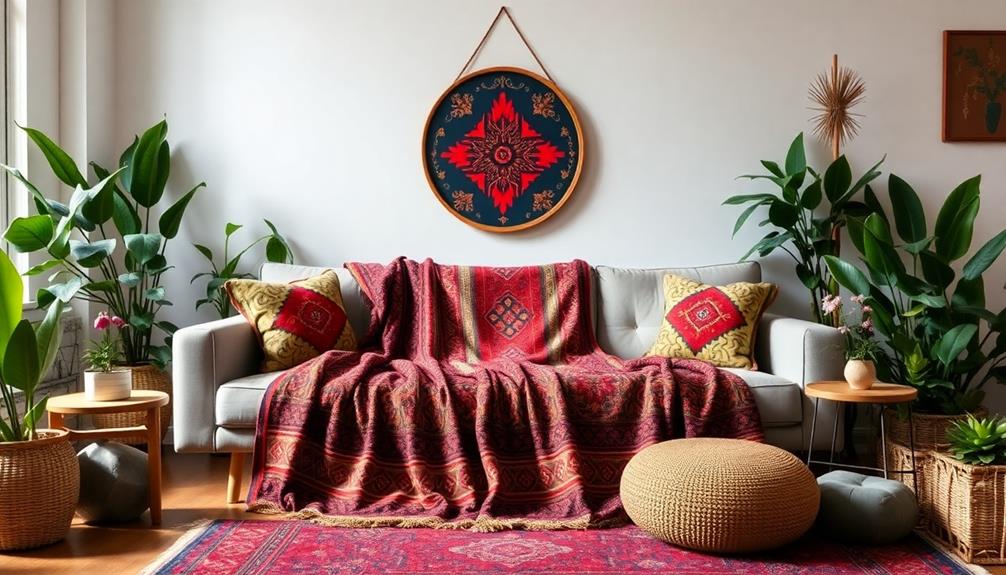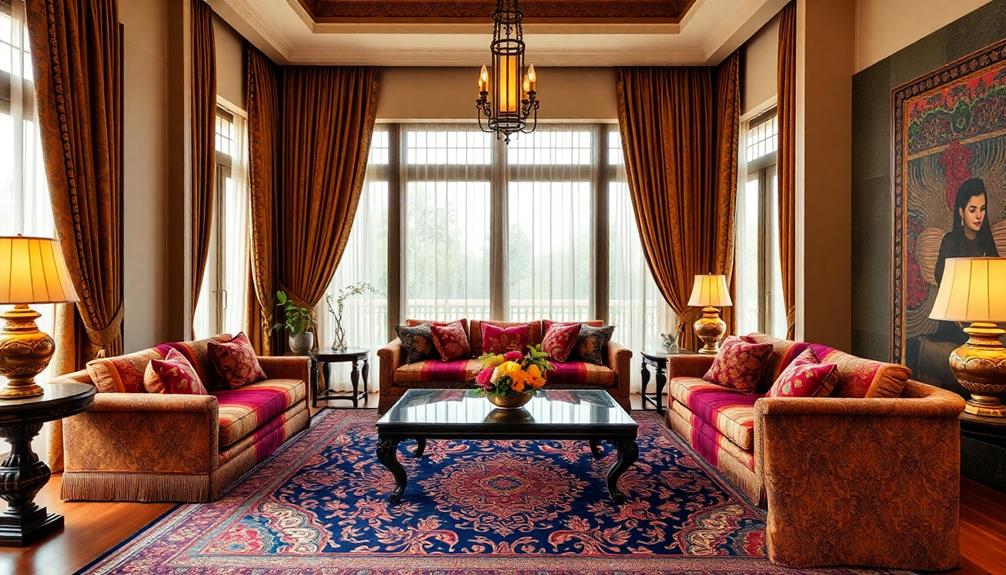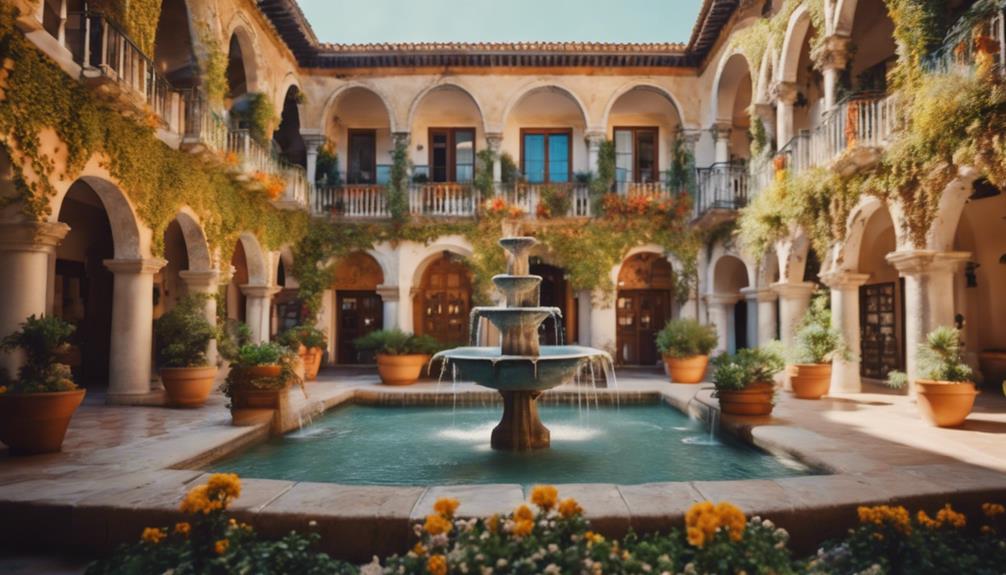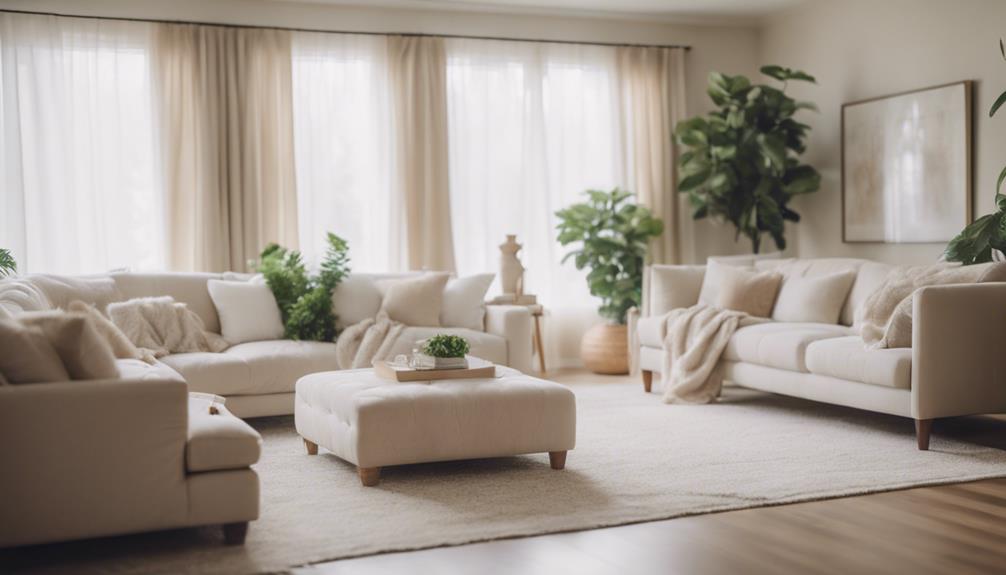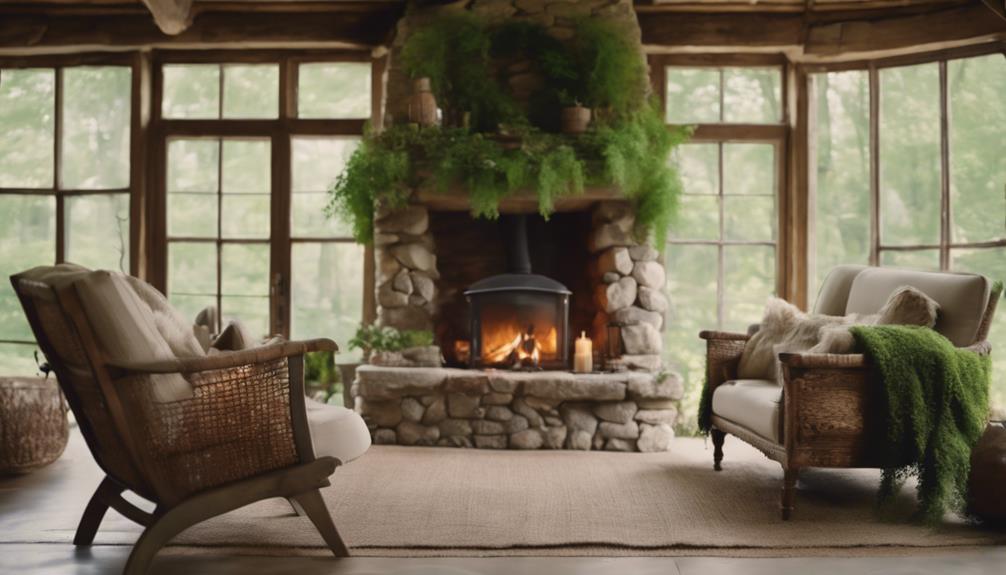Incorporating vibrant batik and intricate ikat from Indonesia can instantly elevate your home’s style. These pieces bring rich cultural heritage and storytelling into your space, showcasing unique designs and colors that resonate with tradition. You’ll not only add visual interest but also create a warm inviting atmosphere. Pair these textiles with eco-friendly elements like bamboo furniture for a harmonious look. Their intricate patterns speak volumes and can become talking points among guests. If you’re curious about how to effectively blend these textiles into your home decor, there’s plenty more to discover.
Key Takeaways
- Incorporate vibrant Indonesian textiles like Batik and Ikat to add cultural significance and striking color to your home decor.
- Utilize eco-friendly textiles made from natural fibers, promoting sustainability while enhancing the aesthetic appeal of your interiors.
- Embrace traditional weaving techniques, showcasing unique patterns and storytelling that reflect Indonesia's rich cultural heritage.
- Mix textiles with sustainable furniture elements, such as bamboo or rattan, to create a harmonious and stylish living space.
- Personalize your decor with custom textile designs, allowing for individuality while supporting artisanal craftsmanship and local culture.
Overview of Indonesian Textiles

Indonesian textiles stand out for their intricate craftsmanship and rich cultural heritage. Renowned techniques like Batik, Ikat, and Songket showcase the skill and artistry that have been passed down through generations.
These textiles aren't just fabrics; they're a reflection of the nation's identity, offering unique designs that can elevate any home decor. Incorporating Indonesian Decorative Pillows into your space can enhance comfort while showcasing vibrant colors and patterns.
As urbanization and rising disposable incomes increase demand, more people are turning to Indonesian textiles for their vibrant colors and striking patterns. These pieces can instantly transform your living space, adding a touch of exotic flair.
Plus, with a growing interest in sustainability, many artisans are now using eco-friendly materials and biodegradable fabrics. This shift towards sustainable textiles isn't just a trend; it's a commitment to preserving the environment while celebrating traditional craftsmanship.
Cultural Significance of Textiles
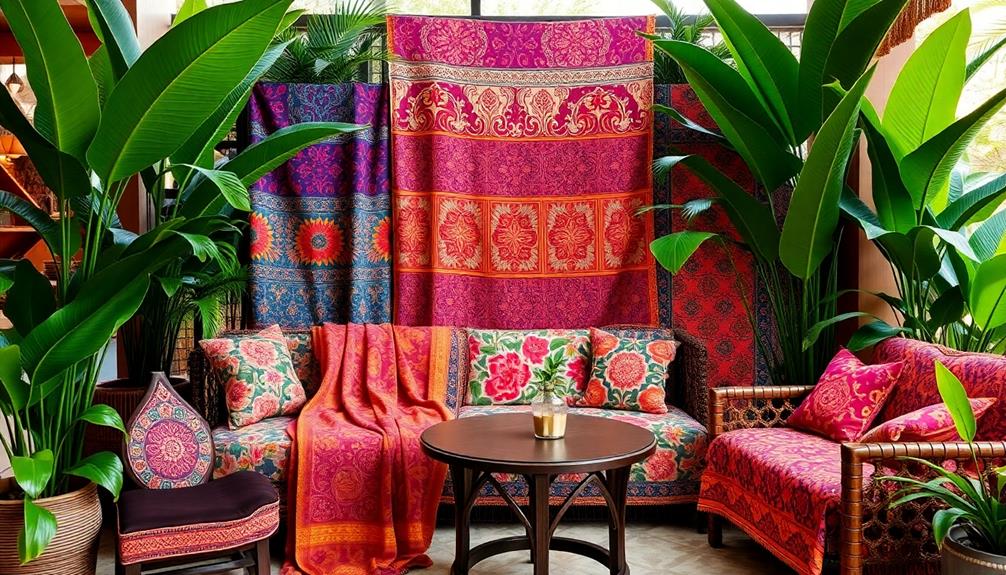
When you explore Indonesian textiles, you'll discover the rich tapestry of traditional weaving techniques that tell stories through their intricate designs.
Each pattern carries symbolism, reflecting local beliefs and cultural narratives that have been passed down through generations.
Additionally, these textiles often feature vibrant colors and unique patterns that are reminiscent of traditional crafts such as the Face Indonesian Decor Mask, further enhancing the cultural significance of your decor.
Traditional Weaving Techniques
Nestled within Indonesia's rich tapestry of culture, traditional weaving techniques like Batik, Ikat, and Songket serve as more than just artistic endeavors; they embody deep-seated cultural stories and values.
These artisanal textiles reflect the craftsmanship and storytelling traditions that have been passed down through generations, much like the intricate designs of Indonesian decor masks that also portray local myths and folklore.
Here are three key aspects of these traditional techniques:
- Batik: Recognized by UNESCO, this wax-resist dyeing method creates intricate patterns that symbolize various aspects of Indonesian life and spirituality, making each piece a narrative of its own.
- Ikat: Using a unique tie-dyeing method before weaving, Ikat results in vibrant patterns often found in ceremonial clothing. This technique showcases the artistry and skill of local artisans, adding depth to the textiles.
- Songket: Characterized by its gold or silver threads, Songket is reserved for special occasions, signifying status and identity. It highlights the cultural narratives embedded in Indonesian textiles, preserving the region's cultural heritage.
Symbolism in Patterns
Textiles from Indonesia aren't just beautiful; they're steeped in rich symbolism that speaks to the heart of the culture. Indonesian textiles, like Batik and Ikat, serve as a visual language, embodying local myths and cultural beliefs. Each pattern holds significance; for instance, a Batik design may symbolize fertility or prosperity, reflecting the community's values and aspirations.
Additionally, these textiles often incorporate traditional motifs that represent regional identities, showcasing the diverse cultural heritage of the nation, as seen in traditional Indonesian housing.
The intricate craftsmanship of these textiles preserves age-old traditions, showcasing the artistry of talented artisans who pass down stories through generations. When you choose these textiles for your home decor, you're not just adding aesthetic appeal—you're inviting a piece of Indonesian heritage into your space.
Colors in textile patterns also carry deep cultural significance. For example, red often represents bravery, while gold symbolizes wealth and nobility. By incorporating these meaningful designs into your home, you celebrate the rich tapestry of Indonesian culture.
In essence, the symbolism found in Indonesian textiles enhances your home decor with layers of meaning, allowing you to express your appreciation for the artistry and heritage behind each piece. Embrace these patterns, and let them tell their stories in your living space.
Popular Textile Types
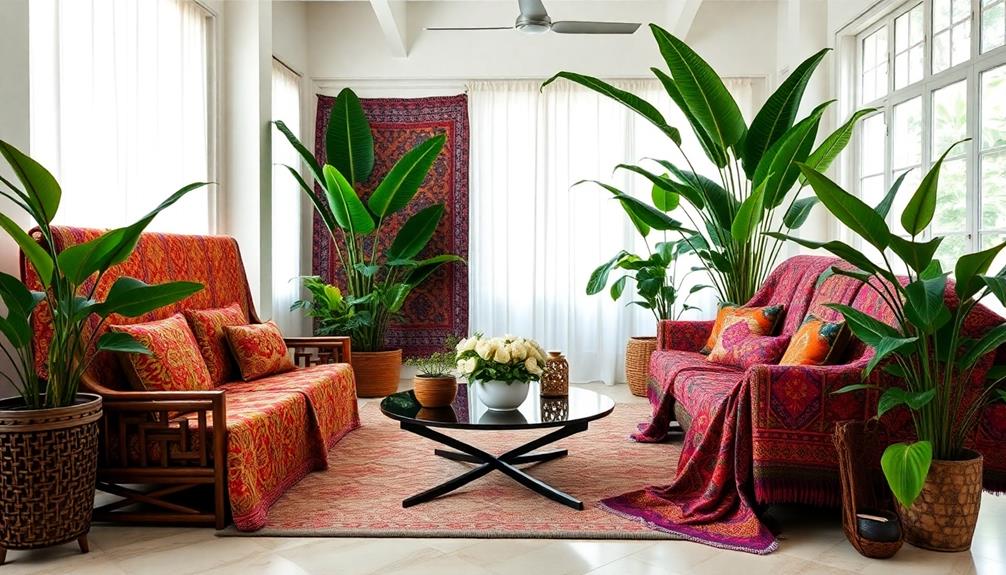
When it comes to popular textile types, Batik stands out with its intricate patterns that tell a story, often inspired by traditional Indonesian artistry.
You'll also love Ikat for its unique weaving techniques that create enchanting blurred designs, making it a beautiful addition to any home.
Additionally, as more people seek sustainable options, eco-friendly textiles are becoming a must-have for modern home styling, allowing consumers to celebrate cultural heritage while being environmentally conscious.
Traditional artistry enhances the overall aesthetic appeal of these textiles.
Batik Patterns and Designs
Many people appreciate the beauty of batik patterns and designs, which are renowned for their intricate craftsmanship and vibrant colors. As a traditional Indonesian textile, batik showcases a rich cultural heritage through its unique motifs.
The process involves wax-resist dyeing, allowing artisans to create stunning, personalized home textiles that reflect identity and artistry. Incorporating batik into your decor not only highlights your style but also aligns with the principles of traditional Indonesian style home decor, emphasizing harmony and natural materials.
Here are three popular batik patterns you might love to incorporate into your home decor:
- Geometric Shapes: These designs offer a modern touch while maintaining tradition, perfect for contemporary spaces.
- Floral Designs: Bringing nature indoors, floral batik patterns can add a rejuvenating vibe to cushions and curtains.
- Scenes from Nature: These patterns tell a story, enhancing the atmosphere of your living space with cultural narratives.
Batik isn't just a textile; it's a conversation starter. By choosing handcrafted designs, you're embracing a piece of Indonesian culture.
With its growing trend in home decor, batik can instantly elevate your style, making your home feel unique and inviting. So why not explore the vibrant world of batik to enhance your living space?
Ikat Weaving Techniques
Embracing the artistry of ikat weaving techniques opens a world of vibrant patterns and rich cultural narratives for your home decor. Ikat is a traditional Indonesian textile method that involves dyeing yarns before weaving, resulting in intricate designs that showcase the region's cultural heritage.
Incorporate traditional batik patterns alongside ikat to create a stunning blend of textiles in your space. Each ikat piece tells a story, often featuring unique patterns that represent nature, community, or cultural symbols, making them true artisan-made treasures.
The process of creating these textiles is labor-intensive, often taking weeks or even months, reflecting the skill of artisans who've perfected their craft over generations. Characterized by their bold motifs and distinctive blurred edges, ikat textiles aren't just beautiful but also sustainable, appealing to those who value handcrafted items.
In recent years, ikat has gained global appeal, with many designers incorporating these vibrant fabrics into high-fashion collections, highlighting their versatility and style.
Sustainable Textile Materials
Sustainable textile materials are reshaping home decor with eco-friendly choices that prioritize both style and environmental responsibility. By opting for these materials, you not only enhance your home's aesthetic but also contribute to a healthier planet.
Incorporating natural materials in design aligns perfectly with the Balinese aesthetic, which emphasizes harmony with the environment. Here are three popular options you might consider:
- Traditional Indonesian Textiles: Fabrics like Batik and Ikat, made using natural dyes and artisanal weaving techniques, celebrate cultural heritage while promoting sustainable practices.
- Organic Cotton: This biodegradable material is grown without harmful chemicals, making it a great choice for eco-conscious consumers seeking soft, durable textiles.
- Natural Fibers: Materials such as bamboo and rattan are lightweight, durable, and biodegradable, providing stylish alternatives that align with your commitment to environmental responsibility.
With the Indonesian government supporting sustainable textile production, you can feel good knowing your choices contribute to reducing carbon footprints.
Incorporating Textiles in Decor
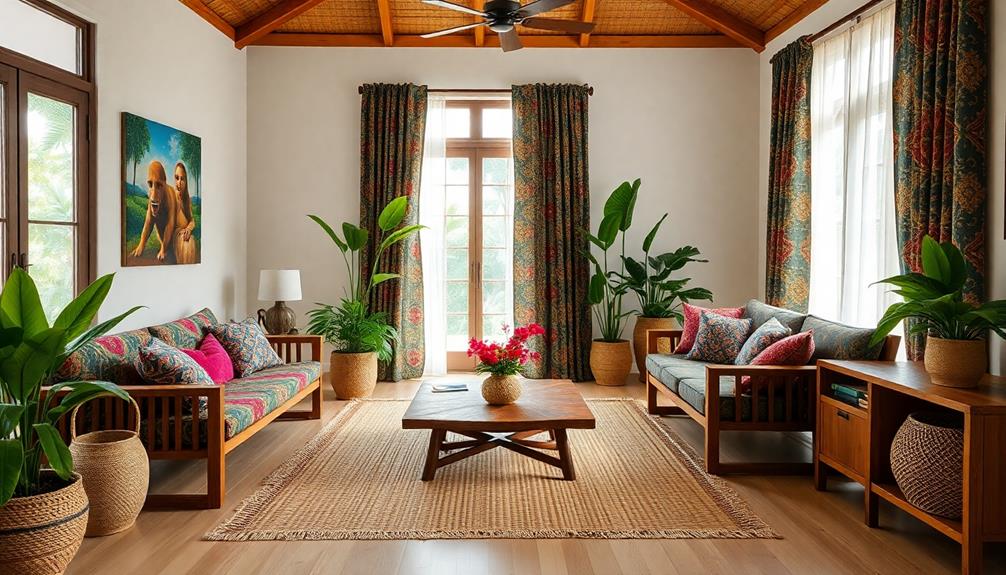
How can you transform your living space into a vibrant reflection of Indonesian culture? Start by incorporating textiles that showcase the beauty of Indonesian decor.
Vibrant textiles like batik and ikat not only add color but also infuse your home with cultural significance and traditional craftsmanship. Pair these textiles with sustainable design elements, such as bamboo or rattan furniture, to create a harmonious connection to nature.
Consider exploring local shops that feature sustainable craftsmanship in Balinese furniture to complement your textile choices.
To elevate your decor, consider integrating handcrafted pottery and intricate wood carvings alongside your textiles. These elements add depth and storytelling to your space, enhancing its aesthetic appeal.
You can also explore the growing trend of personalized designs, opting for made-to-order home textiles that reflect your unique style and cultural identity.
When it comes to color schemes, earthy tones paired with vibrant textiles create a serene ambiance that promotes tranquility in your living environment.
Color and Pattern Combinations
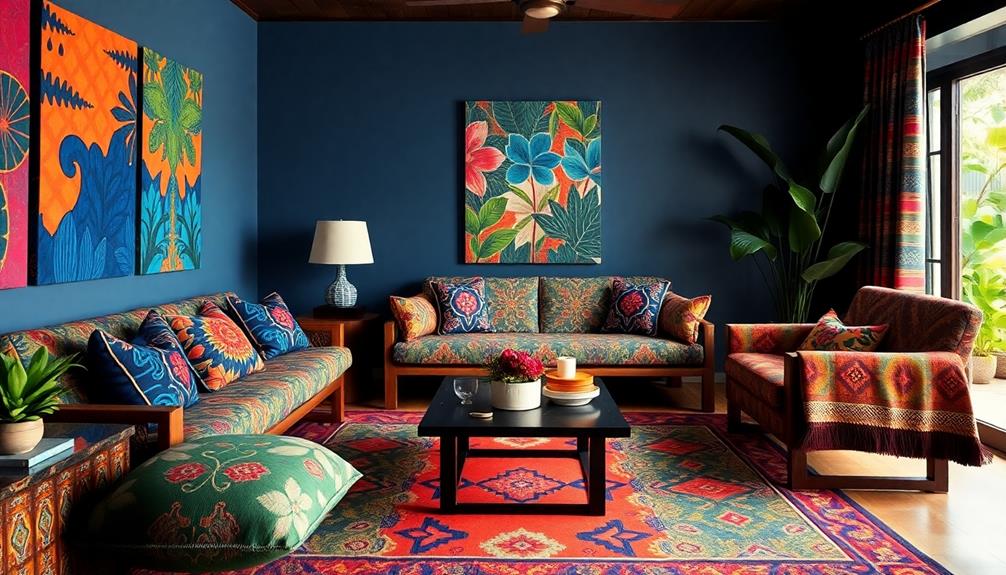
Color and pattern combinations in Indonesian textiles can transform your home into a lively and inviting space. By incorporating vibrant colors and intricate patterns, you can breathe new life into your decor.
The blend of traditional patterns with modern designs offers endless possibilities for unique interior spaces that celebrate cultural heritage. Additionally, using textiles that reflect tropical contemporary house aesthetics can further enhance the visual appeal of your living areas.
Here are three ways to effectively use color and pattern combinations in your home:
- Mix and Match: Combine bold textile prints with earthy color schemes. This creates a harmonious balance, adding visual interest while promoting a sense of tranquility in your living areas.
- Statement Pieces: Use cushions and wall hangings featuring striking color combinations and intricate designs as statement pieces. These will become focal points in your decor, showcasing your appreciation for Indonesian textiles.
- Digitally Printed Textiles: Explore the growing trend of digitally printed textiles. They allow you to customize color and pattern combinations, ensuring your decor is both personal and on-trend.
Embrace the versatility of Indonesian textiles to elevate your home decor, making it a reflection of your style and personality. Incorporate rich batik patterns or handwoven ikat designs into your space for a unique blend of tradition and modernity. Whether it’s vibrant throw pillows, intricate wall hangings, or elegant table runners, **Indonesian textiles for home decor** can bring warmth, color, and cultural depth to any room. By thoughtfully selecting these artisanal pieces, you’re not only beautifying your home but also supporting centuries-old craftsmanship.
Sustainable Textile Practices
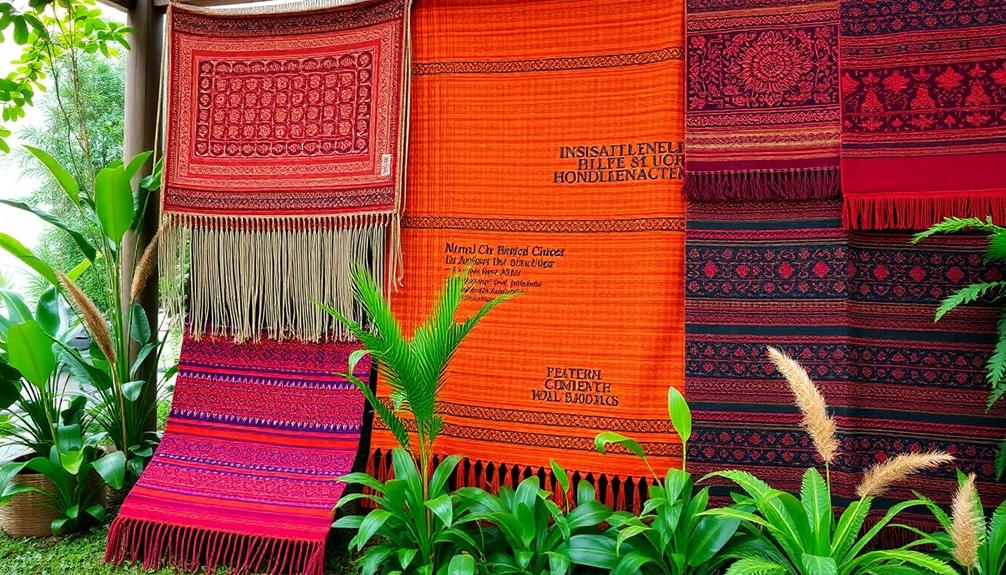
Amid growing concerns about environmental impact, the Indonesian textile industry is embracing sustainable practices that prioritize eco-friendly materials and ethical production.
You'll find that materials like bamboo, rattan, and reclaimed wood are increasingly used to minimize waste and promote responsible sourcing. This shift is largely driven by rising consumer awareness; many shoppers now seek sustainable textiles that align with their values of environmental consciousness.
The adoption of digital printing technologies further enhances these efforts, allowing for lower water usage and reduced waste while supporting unique, customized designs.
Government initiatives like the Industry 4.0 program play a vital role in promoting sustainable practices, emphasizing innovation and the use of advanced technologies to boost efficiency and lower carbon footprints.
As the market for sustainable textiles in Indonesia expands, you'll see a growing emphasis on Fair Trade principles that support local craftsmanship.
By choosing environmentally responsible products, you not only elevate your home's style but also contribute to a more sustainable future.
Embracing these sustainable practices means you're part of a movement that values both aesthetic appeal and ethical production.
Unique Decorative Elements
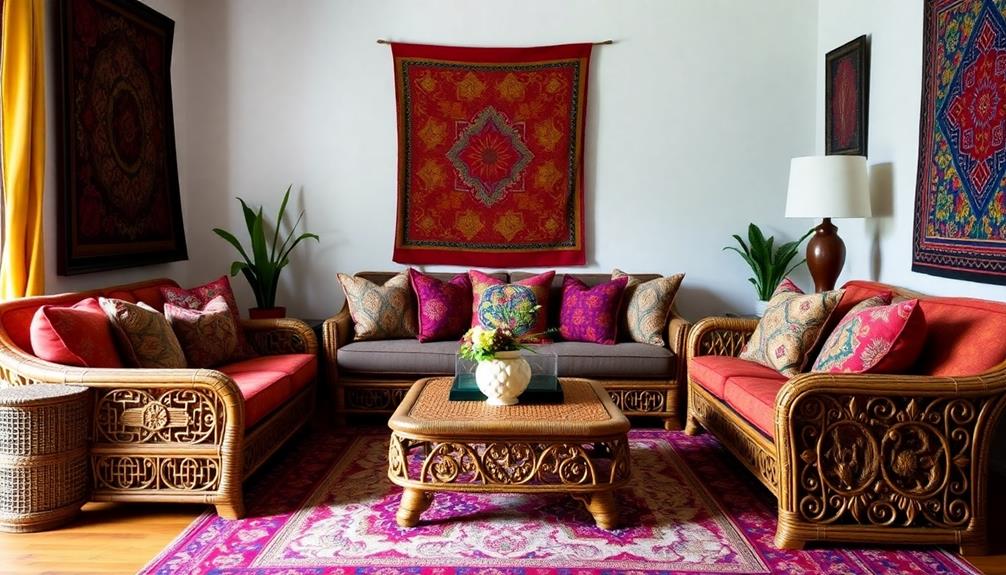
When you incorporate unique decorative elements into your home, you're not just enhancing its aesthetic; you're also telling a story of culture and craftsmanship.
These pieces breathe life into your space while promoting eco-friendly design and sustainability.
Here are three standout elements to evaluate:
- Bamboo Furniture: Stylish and versatile, bamboo furniture is a renewable resource that complements various decor styles. Its eco-conscious credentials make it a smart choice for modern living.
- Animal Rugs: These functional art pieces showcase traditional Indonesian patterns and intricate craftsmanship. They add warmth and visual interest, making them perfect for cozy living spaces.
- Handcrafted Items: Incorporating handcrafted items not only supports local craftsmanship but also introduces a cultural flair to your decor.
Look for unique pieces like Fair Trade Bulawayo gourd baskets or Mella pendant lights to make a statement.
Enhancing Modern Interiors
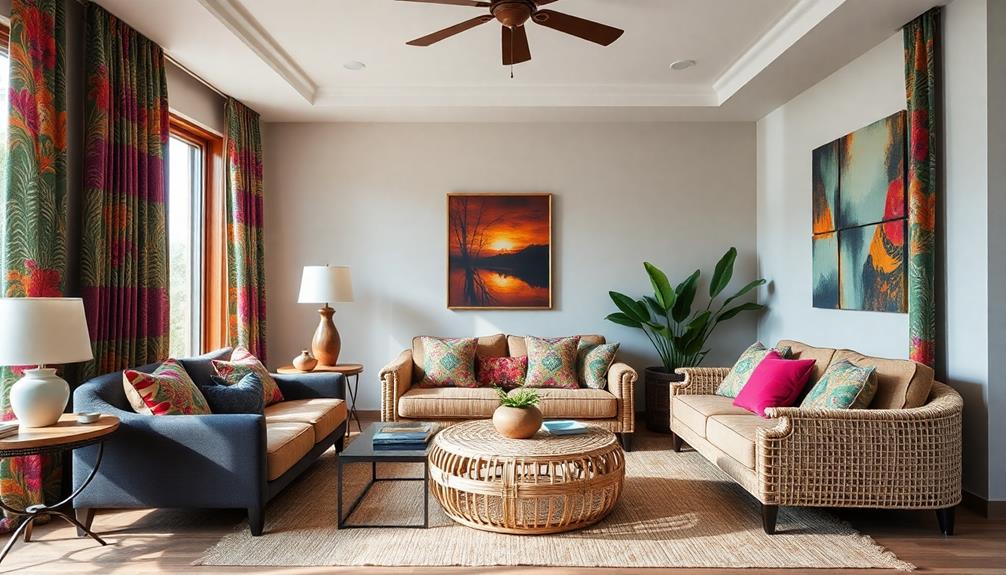
In today's fast-paced world, home textiles play an essential role in enhancing modern interiors, allowing you to express your unique style and personality. With the increasing consumer demand for personalized designs, you can choose textiles that reflect your individuality.
Digitally printed textiles make it easier than ever to incorporate contemporary art into your décor, boosting the aesthetic appeal of your space.
Quality preferences have shifted towards innovative and functional textiles, ensuring that your choices not only enhance visual style but also offer durability and ease of maintenance.
Vibrant Indonesian textiles, such as batik and ikat, add a rich cultural heritage to your home, creating a beautiful fusion of traditional artistry and modern design.
Moreover, the emphasis on eco-friendly materials and sustainable practices in the textile industry aligns perfectly with your desire for a stylish yet responsible home.
By selecting textiles that prioritize sustainability, you enrich your interiors while supporting environmentally conscious initiatives.
Ultimately, enhancing modern interiors with carefully chosen home textiles can transform your living space into a reflection of your values and taste, making your home a true sanctuary of style.
Tips for Choosing Textiles
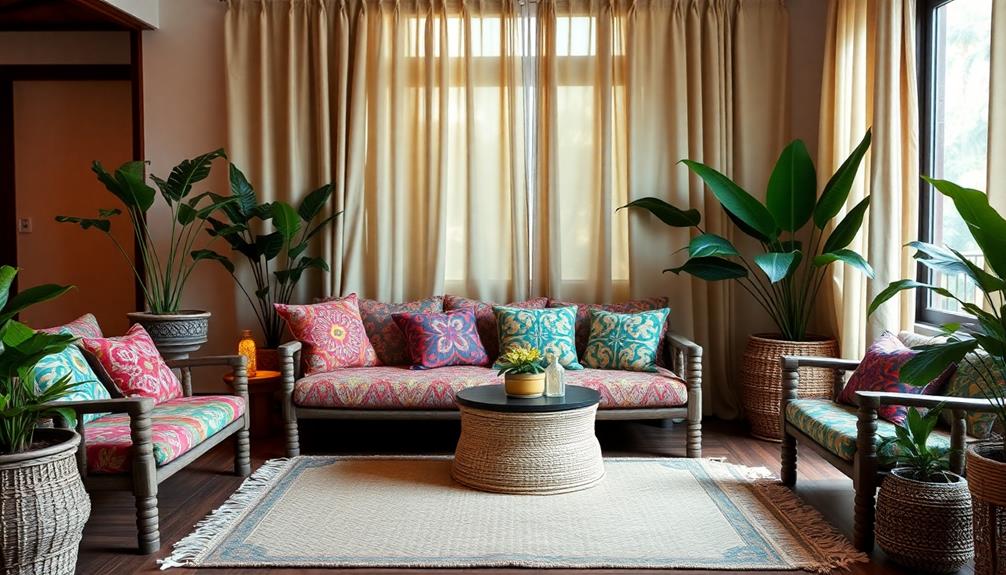
Choosing the right textiles for your home can greatly influence your space's overall vibe, so it's essential to take into account a few key factors. Here are some tips to help you make the best choices:
- Embrace Vibrant Colors: Opt for Indonesian textiles like batik and ikat. These not only add a splash of color but also celebrate the rich cultural heritage and craftsmanship of the region.
- Focus on Functionality: Prioritize high-quality bed linens and bath textiles, as they account for a significant share of the home textiles market. Durable, stylish options will enhance both comfort and aesthetics.
- Prioritize Sustainability: With the rising demand for eco-friendly products, choose sustainable textiles that align with modern consumer preferences. This not only supports the environment but also appeals to fashion trends among urban consumers.
Additionally, explore customization options in home textiles to create unique designs that reflect your personal style.
Frequently Asked Questions
What Is the Indonesian Textile Technique?
Indonesian textile techniques include Batik, Ikat, and Songket. You'll appreciate Batik's intricate patterns, Ikat's unique blurred designs, and Songket's luxurious threads. Each method reflects rich cultural heritage and showcases the artistry of skilled local artisans.
What Is the Form of Textile Design From Indonesia?
Indonesian textile design features vibrant patterns created through techniques like Batik, Ikat, and Songket. You'll find each region showcasing unique styles, reflecting rich cultural heritage, sustainability, and the use of natural dyes in their creations.
What Is the Outlook for the Textile Industry in Indonesia?
The Indonesian textile industry's outlook is as bright as a sunrise, projected to grow considerably by 2029. With rising incomes and consumer demand, you'll see innovation and sustainability shaping its vibrant future.
What Is the Trend of Textile Industry?
The textile industry trend focuses on sustainability, customization, and digital innovation. You'll notice growing demand for eco-friendly products and unique designs, as urbanization and disposable income rise, transforming your shopping experience and home decor choices.
Conclusion
By embracing Indonesian textiles, you're not just adding style; you're honoring a rich cultural heritage that enhances your home's warmth and character. You might worry about blending these bold designs with your existing decor, but trust me, their vibrant colors and intricate patterns can transform any space. Mix and match them thoughtfully, and you'll create a unique look that reflects your personality while celebrating timeless artistry. So go ahead and let these textiles inspire your home!
